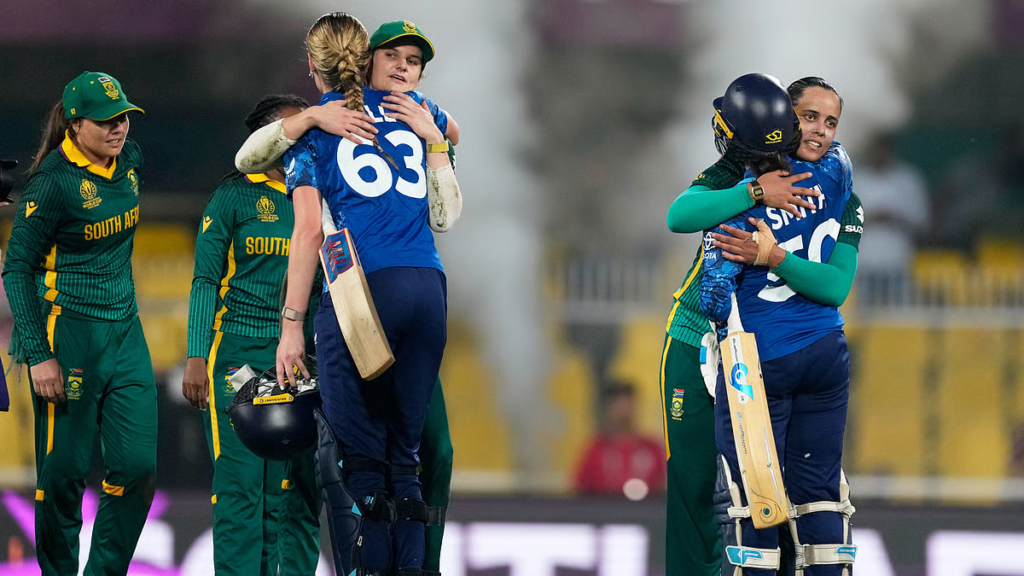
England top-order comes a cropper in disappointing collapse as headless chickens come home to roost at the worst possible time.
Top-order had bailed England out all tournament, but stunning collapse left nowhere to hide.
Headless chickens come home to roost in England’s terminal batting failure.
A runners-up medal in the ODI World Cup months prior, a medalless finish in the 2022 Commonwealth Games, a round-robin elimination in the 2024 T20 World Cup, and a semi-final defeat in the 2023 T20 World Cup. When she took over as England’s coach in April of this year, one of the things she wanted the team to improve on was seizing the big moments under pressure.
After all, Edwards dislikes losing. She has won five Ashes, two World Cups, five domestic crowns, two WPLs, and one hundred during her playing and coaching careers. However, the 125-run deficit of their semi-final loss to South Africa once again brought attention to their faltering batting campaign.
Amy Jones was reminded of missing similar deliveries against Bangladesh and Pakistan by the manner she missed an inducker from Marizanne Kapp for a duck. The troubles of England’s top four against Pakistan’s pace bowlers came flooding back when Heather Knight chopped on for a duck with hesitant footwork. In addition to raising concerns for Jones, Tammy Beaumont, and Knight—all of whom fell for ducks in a knockout match—this also served as a reminder of how little England’s hitters after No. 4 had accomplished in this World Cup.
There was nowhere to hide for England’s poor middle- and lower-order performance if it was the first time they had lost two wickets in an ODI without scoring a run, and if their top three all scored ducks in a scoreline of 1 for 3, the joint-lowest for three-down in the history of 1517 women’s ODIs.
At Guwahati, they were reduced to 78 for 5 by Bangladesh, who were the first to penetrate that batting order. If Knight hadn’t scored an undefeated 79, a defeat there might have served as a sharper reality check for England.
Rain spared Pakistan from their inevitable humiliation as they held England to 133 for 9 in a shortened match, since they were 34 for 0 when it was called off. After moving to a flatter track in Indore, England would have hoped to see some contributions from the lower order against India, but their Nos. 5 to 7 managed all 28 runs combined.
But by the end of the league stage, England’s Nos. 5 through 7 had the lowest average of any side, the second-worst strike rate (61.59), and the same number of fours and sixes as Pakistan.
The results of Alice Capsey, who averaged 21 in the World Cup despite a half-century in the semifinal; Sophia Dunkley, who only managed 68 runs in 133 balls at 11.33; and Emma Lamb, who was substituted for Danni Wyatt-Hodge for the final league game after scoring just 36 runs in five innings, will undoubtedly be scrutinised in Edwards’ analysis of the lower order.
When Wyatt-Hodge took Lamb’s place against New Zealand with nothing for the team at stake, it began to be questioned whether England had relied on Wyatt-Hodge’s experience a bit too late, giving her just seven balls of playing time before the knockout stages.
Wyatt-Hodge’s swift 34 gave England hope, and Capsey’s final knock of 50 while maintaining a century stand with Sciver-Brunt showed some signs of redemption. But the truth is that everything happened a little too late. Edwards claimed they weren’t at their “best” on Wednesday, the day their top three hadn’t scored a single run. The attention now switches to the T20 World Cup, which starts in just over six months, so they will need to perform at their best at home next summer.

